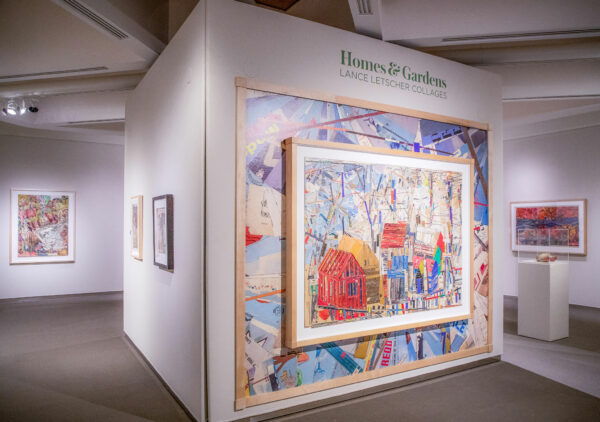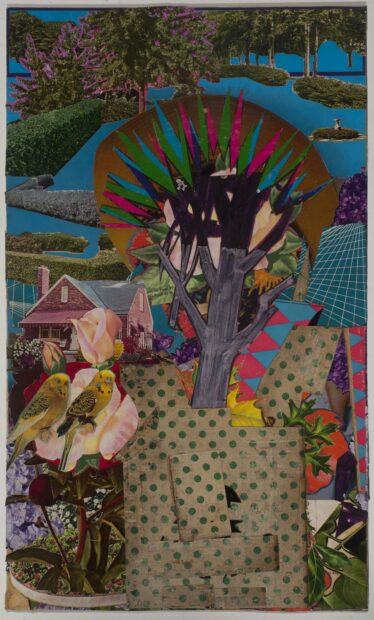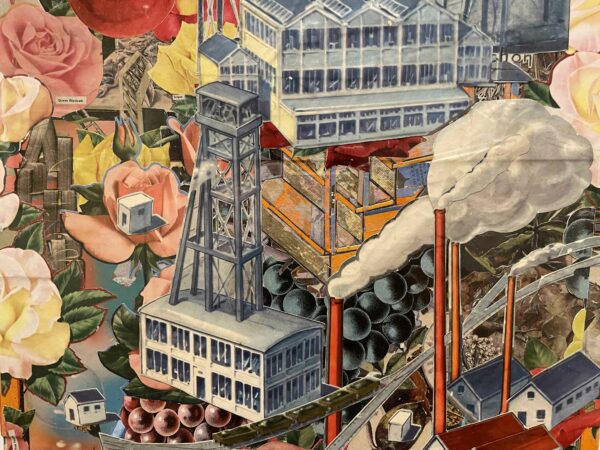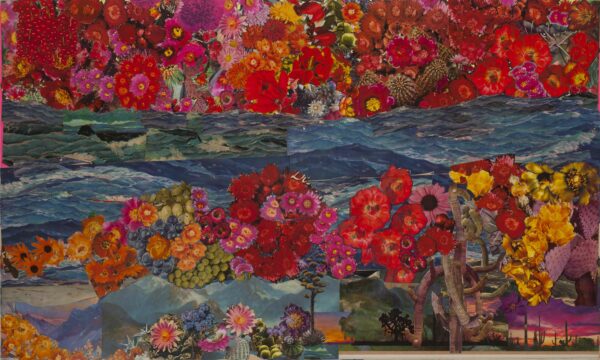
Installation view of “Homes and Gardens: Lance Letscher Collages.” Courtesy of the McNay Art Museum.
Lance Letscher’s collages comment on aesthetic motivations. They face audiences as warped mirrors of consumerism’s effect on both the built and natural environment. Succulent, dazzling, and overflowing, Letscher fuses the imagery and form of manicured nature with that of the repetitious urban landscape. For example, pulled-apart images of flowers, fruits and vegetables, cacti, waves, sunsets, and insects are reimagined alongside, and overlaid on top of, images of factories, warehouses, and large red houses.

Lance Letscher, “Scarecrow,” 2020, collage on board. © Lance Letscher
Similar to cubist collages created by Picasso, a number of works in Homes & Gardens are formally self-referential. Highly aware of his medium of choice, Letscher is clever in how he chooses to display his collages. One such example is in Ladder Drawings, a collaged drawing laid flat on top of a book. The book almost serves as a backboard for the work, as it hangs vertically like a painting. This placement is a compatible pairing, as Letscher’s collage materials are sourced from antique papers, magazines, and other collections, such as the book in question. The drawing pasted on the cover of the book depicts a ladder on the left, paired with an architectural drawing of a bare-bones section of a house with two entrance steps. This basic drawing is one of the only glimpses of authenticity and structure in the exhibition, as these few components hide beneath scores of fabricated exterior appearances. In a sense, Ladder Drawings is at the core of all the other collages on display —it does not present a front of fanciful color wheels or hundreds of flashy pieces.
The title of the exhibition, Homes & Gardens, references Better Homes and Gardens Magazine, and is not only a witty allusion to one of the potential sources of material for Letscher’s collage works. In the case of this show, the title serves as a jumping off point for some of the main ideas circulating within the works. The magazine itself includes commentary and imagery focused around topics of the home, including cooking, gardening, crafts, decorating, and entertaining. One’s home is a medium for representing one’s success, values, and lifestyle. It goes without saying that a home can be seen as a reflection of its inhabitants and their personal drive to want the best, most presentable version of themselves. This increasing level of desire causes people to buy more and more, a trend represented abstractly in this exhibition.

Lance Letscher, “Orange Stair” (detail), collage on board.
On a basic level, one could describe Letscher’s collages as depicting an agglomeration of gardens and contemporary urban landscapes. But the homes and gardens in his collages are not solely “copy and paste” from a magazine. Letscher’s gardens are formed of dreamily intertwined florals and shrubbery that work to create a hive of eye-catching colors and textures. His homes include a recurring big red house vignette and a number of symmetrical warehouse structures. The number of elements in each collage is grandiose, if not grotesque, upon first sight. In this way, Letscher highlights the flaunting of wealth and material possessions that Better Homes and Gardens Magazine teaches viewers to inhabit. He shifts the subtle mode of the magazine into an outrageous presentation of material ostentation.
One example of this is New Studio, a large-scale tin and paper collage on board. In the work, Letscher combines images of artist’s materials (such as paint brushes and paint), with ropes, webbing, clumps of manicured trees, painted landscapes, aerial urban plans, and fiery red plant stalks. Some of these elements are stapled together, adding a three-dimensional element to Letscher’s collage that begins to wear down the illusion of its flat seamlessness. The artist’s materials and painted landscapes in this collage allude to the manipulation of exterior appearance. The clumped arrangement of trees and the detached urban plan also suggest the molding of both natural and architectural landscapes in order to meet aesthetic needs. The collage begins to break apart at the incision of staples and at the point where the red stalks burst through towards the top left corner of the composition. In these areas, the illusion is interrupted as images are hastily pierced together.

Lance Letscher, “Magic Mountain,” 2019, collage on board. © Lance Letscher
Letscher’s collages also subtly deal with the consumption of natural resources. For example, while Orange Stair features industrial imagery, the background of the collage is full of cut-out images of different fruits and flowers, such as grapes, apples, pink and yellow roses, and peaches. Overlaid on top of these sweet plants are black and white cut-outs of industrial warehouses, smoke stacks, and train tracks running through the bottom of the composition. Visually enticing, colorful, and repetitious, the collage shares attributes with methods of advertising and hits a critical chord concerning mass production. The smokestacks and factories included in Orange Stair directly point to this connection. According to the Columbia Climate School website, 45% of global greenhouse gas emissions come from the production of the items that we use and buy on a daily basis. This reads as an attempt by Letscher to draw a connection and take a political stance concerning our aesthetic drive to have and display, and the environmental toll that happens as a consequence of mass production and consumption.
Glazed over with a type of political commentary, Letscher’s works trace the marks left by collage artists of art history’s past. Especially in the earliest collage works, by inventive artists such as Pablo Picasso and Georges Braque, revolution is at the forefront. The traditional deployment of perspective, depth, and line was questioned, and each element’s use shifted in their works. Later on, Hannah Höch integrated text into her collages in order to transmit her Dada commentary. Throughout the history of art, collage subverts what is generally accepted as normal and important.
Letscher’s fabrications offer a vision of a cut-away environment due to the effects of consumerism. Taking on an illusionistic perspective, Letscher’s collage works run the line between fantasy and reality and consider how consumerism has impacted our view of and the appearance of our resources and surroundings.
Homes & Gardens: Lance Letscher Collages is on view at the McNay Art Museum through February 26, 2023.


